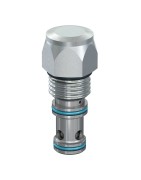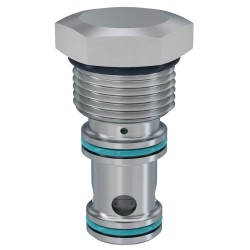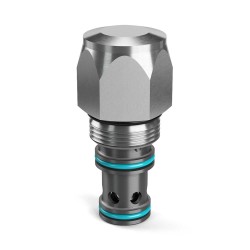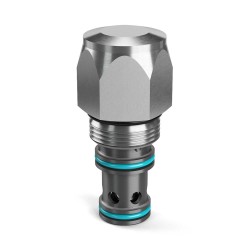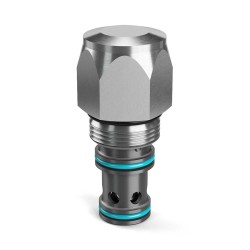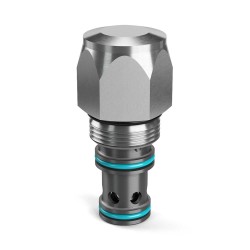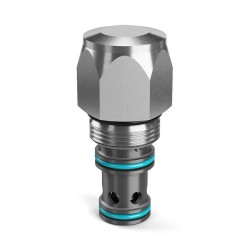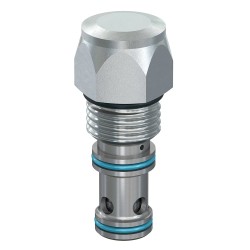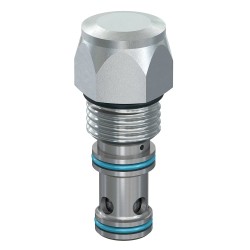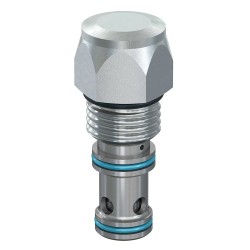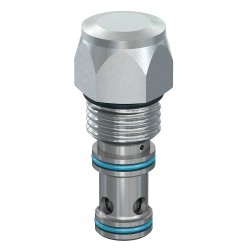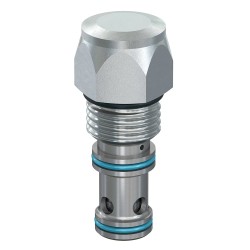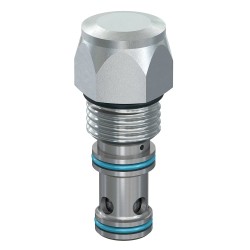Spool Type Logic Element
Spool type logic elements offered by Parker come in four basic variations with multiple sizes for each variation. Different sizes within each variation perform the same, but the larger the size (“_ _”) the more flow the valve is capable of passing. The advantage of using logic element technology is that high flows can be controlled using smaller pilot devices which can lead to more compact and efficient systems. Spool-type logic elements are typically used to control virtually any pressure or flow function since the spool is allowed to modulate. However, spool valves have clearances, so Parker also offers Poppet-Type logic elements for high flow 2-way, 2-position low leak requirements.
The first step to applying logic elements is to determine if the application requires direction, pressure, or flow control. Direction control is typically the simplest due to the fact logic elements are only 2-way devices that can be internally or externally piloted. If pressure or flow control is desired, designers have flexible options that can be implemented by selecting from four basic types of spool-type logic elements. The four types below are grouped together based on whether the valve is normally-open or normally-closed, and internally or externally piloted.
Type 1: _ _SLC2-A and R_ _E3 series are normally closed, external pilot to close cartridges that flow from port 1 to port 2. This simply means that the spool normally blocks flow from port 1 to port 2 due to the internal bias spring. If no external pilot source is applied to the bias spring chamber, via port 3, then flow will pass from port 1 to port 2 at the bias spring pressure setting. When pilot pressure is applied to port 3 it becomes additive to the bias spring setting. Pilot pressure at port 3 needs to be supplied and/or controlled from an external source. Typical high flow functions for these logic elements include pressure reliefs, sequence valves, priority compensation, unloading and load-sense unloading.
Type 2: _ _SLC2-B and R_ _F3 series are identical to Type 1, with the exception of an orifice drilled in the spool allowing pressure from port 1 into the bias spring chamber and port 3, thus providing an internal pilot supply.
Type 3: _ _SLC3-A and R_ _H3 series are normally open, external pilot to open cartridges that flow from port 2 to port 1. This simply means that the spool normally allows flow from port 2 to port 1. If no external pilot source is applied to the bias spring chamber, via port 3, flow from port 2 to port 1 will begin to meter and restrict flow at the bias spring pressure setting. When pressure is applied to port 3 it becomes additive to the spring setting helping to hold the valve open. Pilot pressure at port 3 needs to be supplied and controlled from an external source. Typical high flow functions for these logic elements include restrictive flow control, pressure compensation, and pressure reducing.
Type 4: _ _SLC3-B and R_ _G3 series are identical to Type 3, with the exception of an orifice drilled in the spool allowing pressure from port 1 into the bias spring chamber and port 3, thus providing an internal pilot supply.
Parker’s extensive high flow spool-type logic elements allow for application specific solutions in the most demanding applications and markets including: Power Units, Oil and Gas, Material Handling, Construction, Drills, Presses, Mixers, Agriculture, Balers, Combines, Priority Steering, Priority Braking, High Flow Pressure Compensation, Fixed Pump Unloading, Load-Sense Unloading, Priority Flow Control, etc.
The first step to applying logic elements is to determine if the application requires direction, pressure, or flow control. Direction control is typically the simplest due to the fact logic elements are only 2-way devices that can be internally or externally piloted. If pressure or flow control is desired, designers have flexible options that can be implemented by selecting from four basic types of spool-type logic elements. The four types below are grouped together based on whether the valve is normally-open or normally-closed, and internally or externally piloted.
Type 1: _ _SLC2-A and R_ _E3 series are normally closed, external pilot to close cartridges that flow from port 1 to port 2. This simply means that the spool normally blocks flow from port 1 to port 2 due to the internal bias spring. If no external pilot source is applied to the bias spring chamber, via port 3, then flow will pass from port 1 to port 2 at the bias spring pressure setting. When pilot pressure is applied to port 3 it becomes additive to the bias spring setting. Pilot pressure at port 3 needs to be supplied and/or controlled from an external source. Typical high flow functions for these logic elements include pressure reliefs, sequence valves, priority compensation, unloading and load-sense unloading.
Type 2: _ _SLC2-B and R_ _F3 series are identical to Type 1, with the exception of an orifice drilled in the spool allowing pressure from port 1 into the bias spring chamber and port 3, thus providing an internal pilot supply.
Type 3: _ _SLC3-A and R_ _H3 series are normally open, external pilot to open cartridges that flow from port 2 to port 1. This simply means that the spool normally allows flow from port 2 to port 1. If no external pilot source is applied to the bias spring chamber, via port 3, flow from port 2 to port 1 will begin to meter and restrict flow at the bias spring pressure setting. When pressure is applied to port 3 it becomes additive to the spring setting helping to hold the valve open. Pilot pressure at port 3 needs to be supplied and controlled from an external source. Typical high flow functions for these logic elements include restrictive flow control, pressure compensation, and pressure reducing.
Type 4: _ _SLC3-B and R_ _G3 series are identical to Type 3, with the exception of an orifice drilled in the spool allowing pressure from port 1 into the bias spring chamber and port 3, thus providing an internal pilot supply.
Parker’s extensive high flow spool-type logic elements allow for application specific solutions in the most demanding applications and markets including: Power Units, Oil and Gas, Material Handling, Construction, Drills, Presses, Mixers, Agriculture, Balers, Combines, Priority Steering, Priority Braking, High Flow Pressure Compensation, Fixed Pump Unloading, Load-Sense Unloading, Priority Flow Control, etc.
